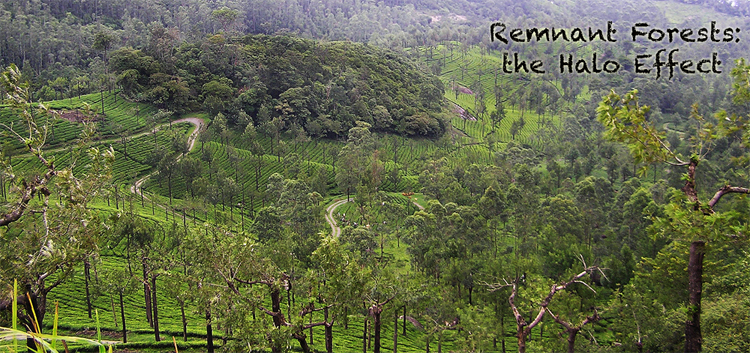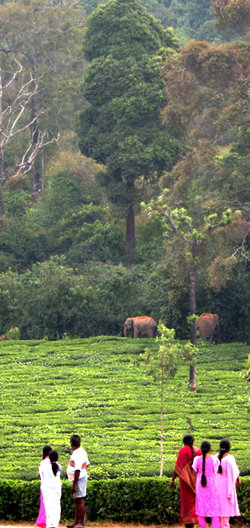Remnant Forests: the Halo Effect

Rainforest remnant in tea plantation under Silver Oak. Manimuthar, near Kalakkad Mundanthurai Tiger Reserve, Tamil Nadu. Photo: M.O. Anand. Edited: Geoff Hyde.
More so than for most other hotspots, the impact of people on the ecology of the Western Ghats needs to be understood and managed. According to the Conservation International site, the Western Ghats have the third-highest population density of all the hotspots: 261 people per square km, which is over six times the world’s average population density. In the Western Ghats the total land area dominated by people is now about twice that of the remaining natural habitats, and the populated and natural areas are extremely interwoven in a giant, landscape-level mosaic. The special challenges of the Western Ghats, and our ignorance of how to manage human land-use in them, inspired a study just published in the journal Biological Conservation (see Abstract here), with inputs from scientists affiliated with NCBS and five other Indian and American centres (full list at bottom of article). Its first author is current NCBS graduate student M.O. Anand.

Elephants on the move from the Indira Gandhi Tiger Reserve (Tamil Nadu) through tea plantations towards a large man-made reservoir. Photo: M.O. Anand.
Previous studies in other countries had indicated that loss of biodiversity in a heterogeneous landscape like that of the Western Ghats could be tempered in two main ways. In the first approach, wildlife-friendly farming practices are used. The intensity of farming is decreased, and the farmer will include vegetation that is as varied as possible, both structurally and species-wise. For example, older-style coffee plantations in the Western Ghats grow their plants under a diverse assortment of shade trees, intermixed with commercial crops of pepper, citrus, areca nut and vanilla. The second main approach is to set aside areas within or near farmlands for natural forest vegetation. An individual farmer clearing land for a new farm, for example, would be encouraged to preserve one or more islands of the original vegetation.
Anand and the team wanted to know if either or both of the wildlife-friendly farming and set-aside approaches would be helpful in the Western Ghats. While there were no relevant prior reports for the Western Ghats as a whole, the team pooled the results of 35 localized studies from the past to obtain a more general perspective. These prior studies had compared the biodiversity of the cultivated areas to that of nearby natural forests in many parts of the Western Ghats, and had (as a whole) included many types of mammals, birds, fish, reptiles, amphibians, insects, plants and fungi. By pooling all the prior data, Anand and the team were in a good position to see trends that might not otherwise show up when the focus was taxonomically too narrow.
While the results provided no evidence of any beneficial effect from wildlife-friendly farming, plant and vertebrate biodiversity was retained in cultivated areas in direct proportion to the acreage of natural forest in the vicinity. In other studies, fragments of natural forest have been found to exert what has been called a “halo effect”. They serve as safe havens for animals that are either feeding in, or migrating across, the cultivated areas. In the current study, no pattern emerged for invertebrates, but overall the findings provide strong support for the set-aside approach.
Only one third of the forests of the Western Ghats currently enjoy the highest possible level of security, as Protected Areas. The remainder, many of which are under corporate or private ownership have weaker levels of protection, or none. These forests are facing many pressures that could lead to them being either directly cleared for cultivation and logging, or indirectly degraded. The current study indicates that their preservation must be given the highest priority. Or as the team puts it in their paper’s title: “Remnant forests matter”.
Centres involved in the study
Ashoka Trust for Research in Ecology and Environment, Bangalore; Centre for Wildlife Studies, Bangalore; National Centre for Biological Sciences, Bangalore; Nature Conservation Foundation, Mysore; Resilience and Adaptation Program, University of Alaska, Fairbanks; Wildlife Conservation Society, Bangalore.

Comments
Post new comment